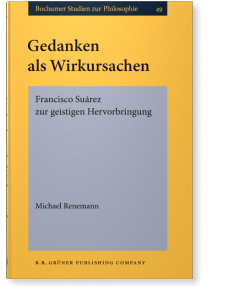Gedanken als Wirkursachen
Francisco Suárez zur geistigen Hervorbringung
Francisco Suárez (1548–1617) sieht es als Problem an, dass nach dem traditionellen Modell der Kunstproduktion der Gedanke immer nur als Vorkonzeption und damit auf sehr vermittelte Weise in das Kunstwerk eingeht. Entsprechend wäre auch die Analyse von geistigen Hervorbringungen immer ein Prozess, bei dem die Gedanken als etwas hinter dem Gesagten Liegendes rekonstruiert werden müssten. Suárez verwirft dieses auf Nachahmung beruhende Modell und verwendet die Unterscheidung zwischen dem Denkakt – verstanden als "Blick des Geistes" – und dem gedachten Inhalt, um ein ganz neues Modell zu entwickeln. Für ihn ist es die Aufmerksamkeit des Malers, die den Pinsel führt und die so dafür sorgt, dass eine anfangs noch leere formale Repräsentation sich anfüllt.
Während die Innovation von Suárez zunächst keinen Widerhall findet, könnte sie ein Fundament sein für viel spätere Weisen, die Kunst aufzufassen, z. B. für die formalistische Schule der Kunstgeschichte oder für einen Künstler wie Paul Klee, der sagt: "Kunst gibt nicht das Sichtbare wieder, sondern macht sichtbar."
Francisco Suárez (1548–1617) considers it to be problematic that, according to the traditional model of art production, thought only enters a piece of art obliquely, as preconception. Consequently, any analysis of mental creations would have to be a process whereby thoughts are reconstructed as something that lies behind that which is being said. Suárez rejects this imitation-based model and uses the distinction between act of thought – considered as "focus of the mind" – and the cognized content to develop a completely new model. For him, it is the artist's attention which guides the brush and which thus causes the initially empty representation to be filled.
While Suárez's innovation hardly received any immediate reaction, it can be considered as a foundation for later approaches to art, e.g. for the formalistic school of art history or for an artist like Paul Klee, who says: "Art does not reproduce what is visible, but rather produces visibility".
Table of Contents
-
Vorwort | p. v
-
1. Einleitung | pp. 1–14
-
Teil I. Die Positionen des 13. und 14. Jahrhunderts
-
2. Thomas von Aquin | pp. 17–20
-
3. Johannes Duns Scotus | pp. 21–28
-
4. Petrus Aureoli | pp. 29–48
-
5. Wilhelm von Ockham | pp. 49–58
-
Teil II. Die Positionen des 16. und 17. Jahrhunderts
-
6. Pedro da Fonseca | pp. 59–78
-
7. Pedro Hurtado de Mendoza | pp. 79–80
-
8. Johannes a Sancto Thoma | pp. 81–84
-
9. Rodrigo de Arriaga | pp. 85–86
-
10. Francisco de Oviedo | pp. 87–88
-
11. Johannes Poncius | pp. 89–94
-
12. Richard Lynch | pp. 95–100
-
Teil III. Francisco Suárez
-
13. Suárez zur Unterscheidung zwischen conceptus formalis und conceptus obiectivus | pp. 103–118
-
14. Suárez zu Ideen | pp. 119–128
-
15. Praktischer und spekulativer Intellekt | pp. 129–132
-
16. Überblick: Suárez und sein Umfeld | pp. 133–144
-
17. Ausblick I: Suárez und Descartes | pp. 145–150
-
18. Ausblick II: Kunst und Kunsttheorien im 19. und 20. Jahrhundert | pp. 151–160
-
Literatur | pp. 161–168
-
Namenregister | pp. 169–170
-
Sachregister | pp. 171–173
Cited by (4)
Cited by 4 other publications
This list is based on CrossRef data as of 18 july 2024. Please note that it may not be complete. Sources presented here have been supplied by the respective publishers. Any errors therein should be reported to them.
